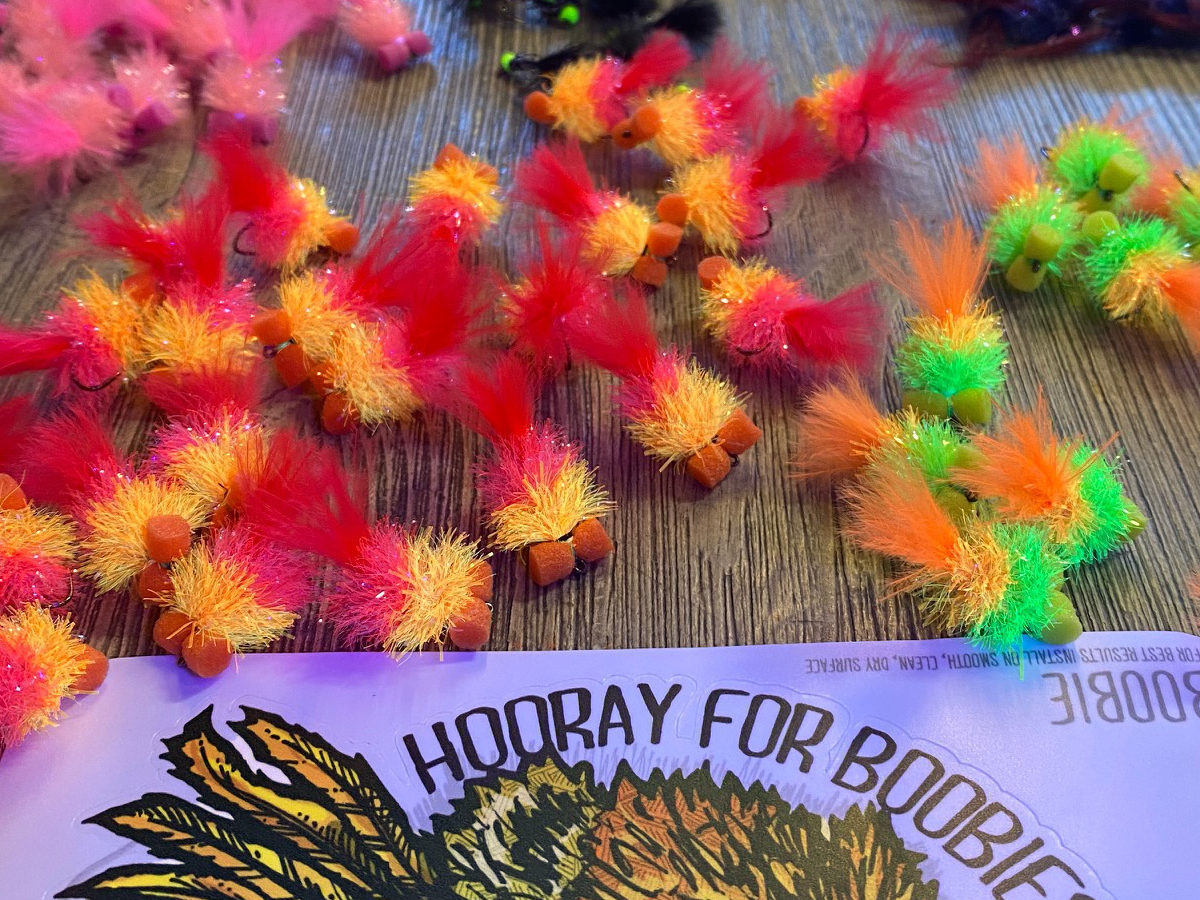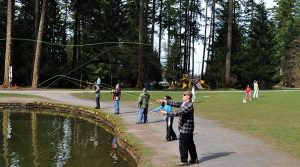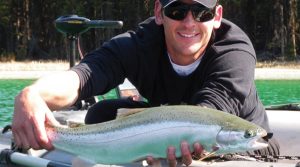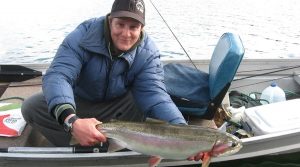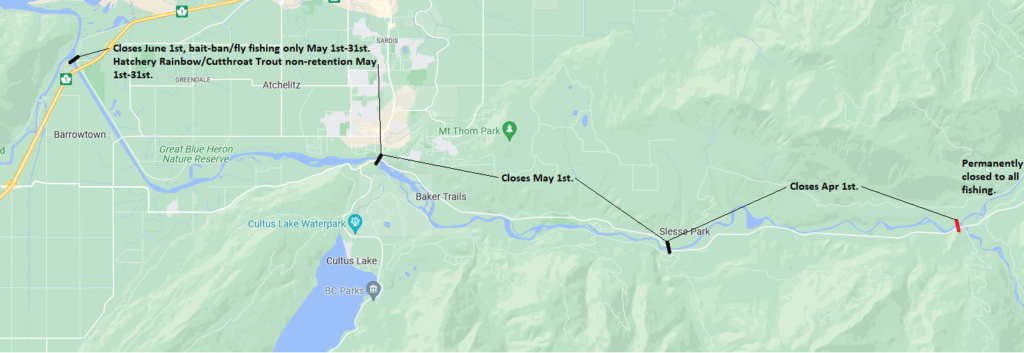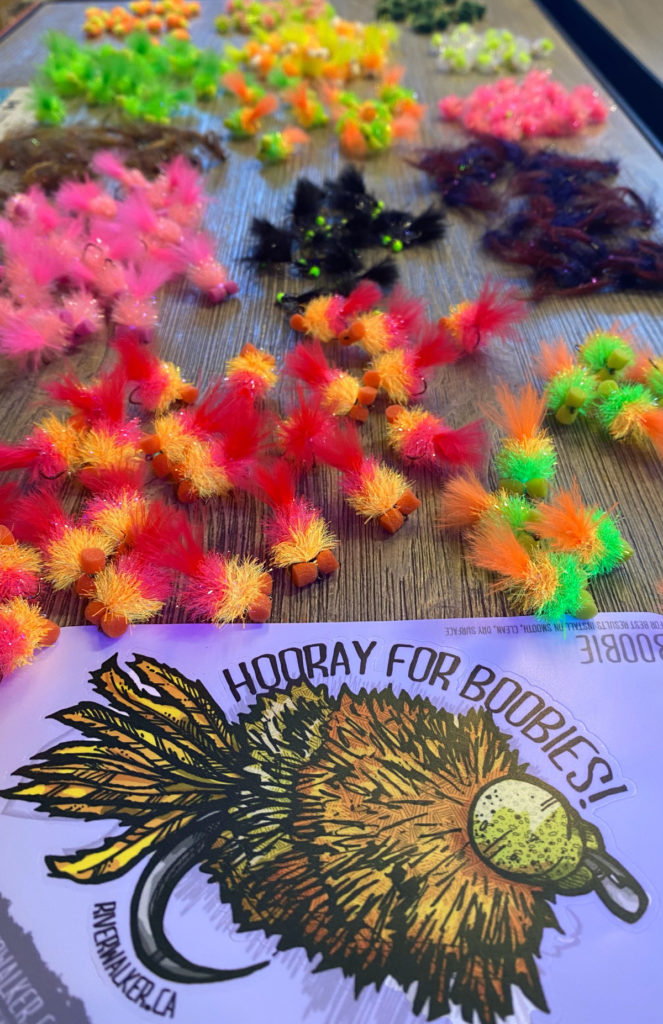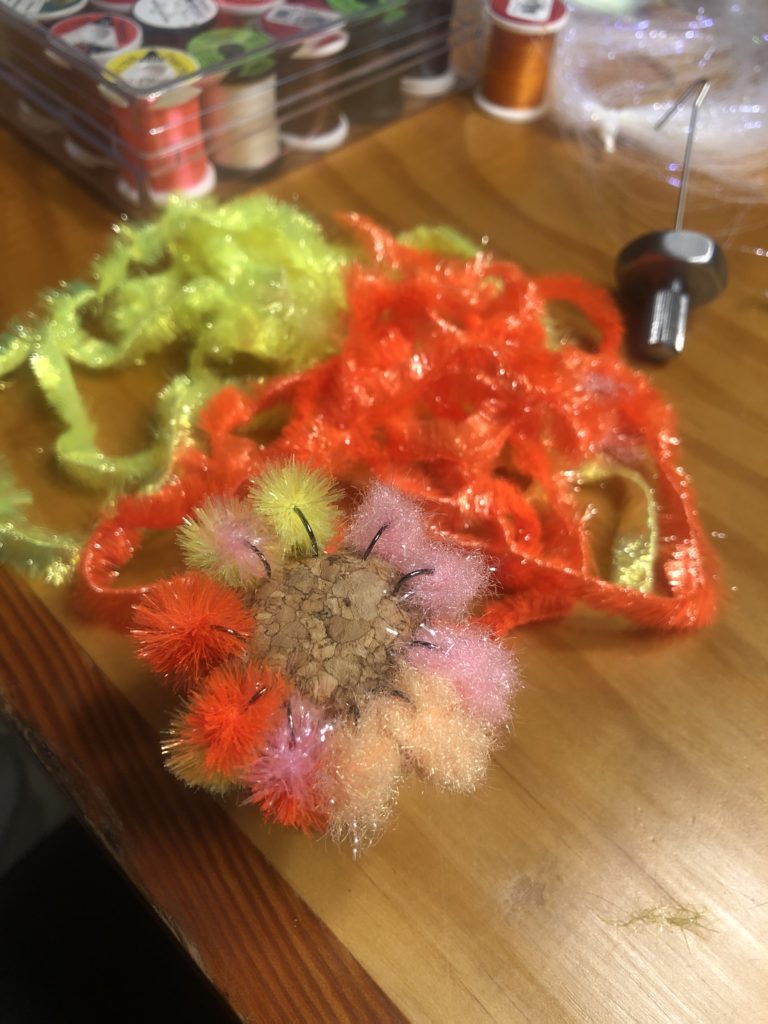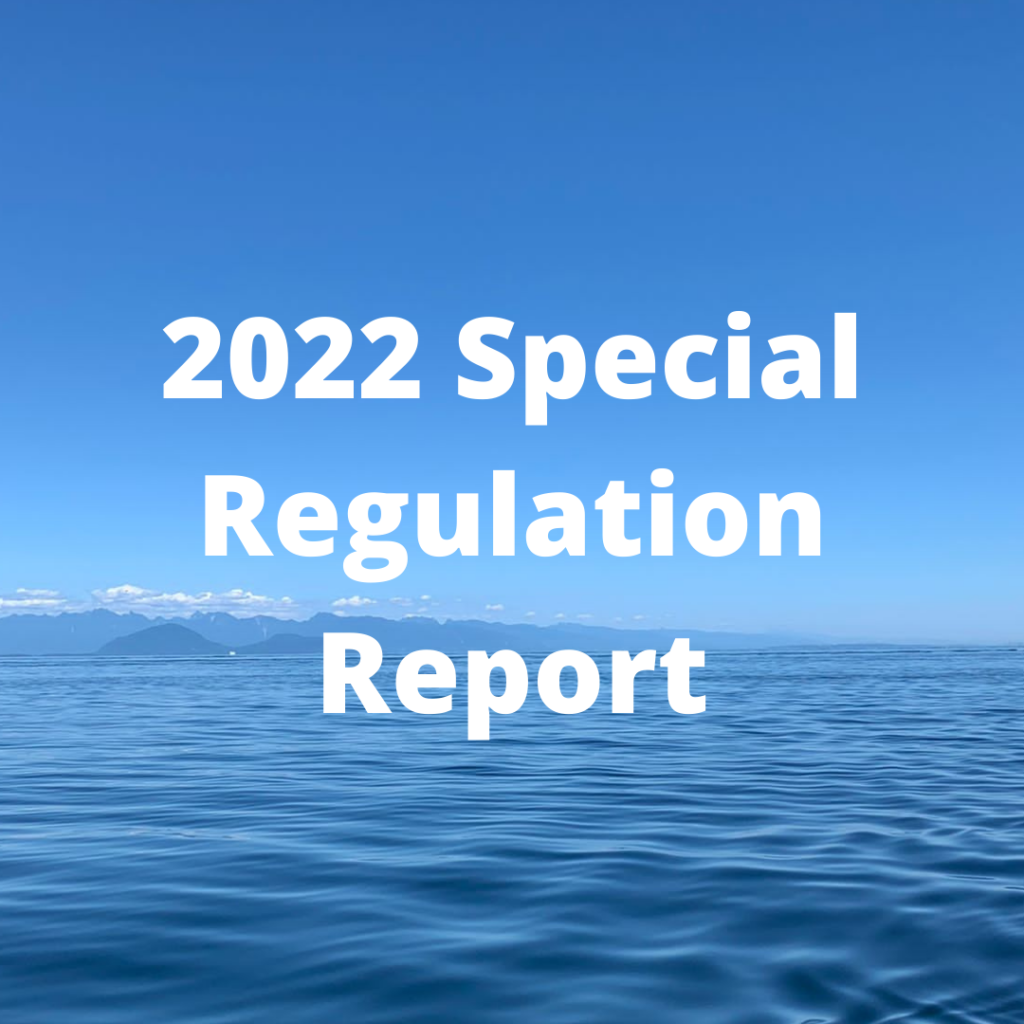OUTLOOK
A spring storm is incoming! Overall, this is a good thing but you will want to watch your river levels and marine forecasts if you are heading out over the next 5 days. Sunday looks like it will be a wet one. All systems could use some water so it should be a good weekend to get out.
The other big fishing news is the saltwater regulation changes that come into effect today, April 1. Jason is tuning in this week with a special update on those regulations and what it means for our season ahead!
On the saltwater regulation front, Bob Zimmer has been hard at work trying to get answers from Ottawa concerning possible acceptance of modest, science-based proposals that will allow Vancouver area anglers to fish for hatchery chinook, while easily protecting stocks of concern. Be sure to have a read of Jason’s regulation update below but take a look at this video and show him some support for voicing our concerns to Minister Murray – Click here for the Video.
In the interior, we are hearing the first ice off reports and we have another primer piece from Sterling. This week, he will go over what we have heard on the lakes that are fishing and he has an article on how to fish blobs which is one for the most effective early season tactics. Also, on the lake train of thought, I’m teaching an Introduction to Fly Fishing Lakes zoom course next week for anyone who is looking to learn about lake fishing or to brush up on some of their skills.
Another fishery to have on the radar is sturgeon fishing. It is picking up. Water is warming and eulachons are starting to show up. Traditionally, studies show they run late Feb to late May with the peak of the run usually sometime in April. Productive baits this time of year are of course eulachons, roe, and lamprey. If you are looking for something to do over the next few weeks, dinosaur hunting should be on the list!
Finally, a friendly reminder that it is new license season. As of today, you will need a new license if you are heading out on the water!
Both fresh and saltwater licenses are purchased online. If you are in need of a freshwater license you can purchase that here and your saltwater fishing licenses are purchased here.
Note: We do not issue licenses in store but the online process is very straightforward – If you are having issues getting your license online, we can help. Call the store and we can walk you through the process
On to the report!!
CLASSES AND COURSES
INTRODUCTION TO FLY FISHING
This course was specifically designed to give the new fly fisher the basic knowledge, casting skills and fly fishing strategies to effectively fish our local BC waters. This course is comprised of two sessions; 3hr evening seminar and a 3hr casting session. The dates below show the seminar date first and casting date second.
Dates: (Apr 6 & 9), (May 10 & 14), (Jun 15 & 18), (July 12 & 17), (Sept 20 & 24)
Cost: $150.00 + GST
Seminar Time: 6:30pm – 9:30pm
Casting Time(s): 10am – 1pm or 1:30pm -4:30pm
INTRODUCTION TO CHIRONOMID TECHNIQUES
Chironomids are the number one food source for trout in BC’s lakes; however, few anglers have taken the time to become true masters of this discipline. Those that do are often rewarded with the largest fish. Trevor is a former member of the Canadian Fly Fishing Team and an excellent chironomid angler. Dedication to his sport has helped Trevor become one of the top fly fishermen in the province as well as a fisheries biologist. This course is comprised of one 3hr evening seminar. Content is for beginner to advanced.
Cost: $50.00+GST
Zoom Seminar Date: Wednesday, April 27
Zoom Seminar Time: 6:30-9:30 pm
INTRODUCTION TO FLY FISHING LAKES
This course will give you an in-depth look at the fundamentals of fly fishing lakes. We explore equipment, techniques, major insect hatches, and ideal lakes to begin with. You will learn all you need to plan your next successful lake trip to one of BC’s 5,000 lakes! This course is comprised of one 3hr evening seminar.
Cost: $50.00+GST
Zoom Seminar Date: April 5
Zoom Seminar Time: 6:30-9:30 pm
INDUSTRY EVENTS AND UPDATES
If you missed it in the Outlook, a friendly reminder the April 1 marks the start of a new licence year!
Both fresh and saltwater licenses are purchased online. If you are in need of a freshwater license you can purchase that here and your saltwater fishing licenses are purchased here.
Note: We do not issue licenses in store but the online process is very straightforward – If you are having issues getting your license online, we can help. Call the store and we can walk you through the process.
FRESHWATER FISHING REPORTS
Vedder/Chilliwack Fishing Report
For those who are planning on heading out to the Vedder/Chilliwack, note that the Chilliwack River will be closed to all fishing upstream of the Tamihi bridge as of April 1st. To clarify, this means that the last day to fish this section of the river will be March 31st, as the river officially closes at 12:01am on April 1st. This is a fairly new regulation that is part of a “rolling closure” that was released last year to “protect spawning wild steelhead”, so some less-informed anglers may not be aware of it. The “mid-river”, from the Vedder Crossing bridge to the Tamihi bridge, will remain open until May 1st, and the “lower-river”, downstream of the Vedder Crossing bridge, will close on June 1st. Note that the lower river is fly fishing only between May 1st-31st and hatchery trout must be released in the month of May. Please see the map below for a visual representation of the above.
Now that that’s out of the way, here’s a quick report on how the river has been fishing:
Those who have been able to adapt to the “new” river and its associated conditions have been continuing to find fish, as expected. Water levels jumped late last week with the rain, and a batch of fresh fish rolled in as a result, leading to some good fishing for the previously mentioned adaptable anglers. Levels did drop mid-week but are now rising again, which may be due to some snowmelt from the few warm days we’ve had. The weather forecast has been all over the place for the past few days, so it’s hard to say what the river will do for the weekend- that’ll depend on how much it rains, and how warm it gets. If conditions stay good, we can expect there to be some fish moving around with slightly higher water levels. Bring an assortment of gear to cover whatever conditions the river throws at you.
It’s getting later in the season, so there will be a fair number of darker fish around; some of these fish will have been in the river since December or January. They usually don’t eat too much in the river and will have been living off their fat reserves for the most part, so it’s usually a good idea to avoid these senior citizens if possible. If you do hook one, make every attempt to land it quickly, minimize handling and get it released ASAP. A vast majority of the dark fish will be wild, and they have usually been hooked several times at this point, so minimizing stress for these fish is a good idea. There will also be some salmon fry around, so avoid wading through backchannels and other prime fry habitat whenever possible.
Squamish River Fishing Report
This past week has seen a few anglers encountering trout and char with a little more consistency than those of weeks past. Water levels continue to be low and clear but reports have noted that there appears to be a bit of melt and colour as the day progresses.
This next week will see some warm-ish temperatures around 8 degrees and lots of rain. This should hopefully start to colour the water a bit and bump it enough to shuffle and move fish around.
Spinners and spoons are still great options as the trout and char will start to transition to fry as a food source. Stripping or drifting fry and alevin patterns on lighter fly rods can be a great tactic when you see the fish rolling and boiling on the fry. As the season continues into April and May, beads, bobs, worms, and blades are all great ideas and choices.
If you like to swing flies, char and trout won’t say no. Smaller and sparse patterns in the morning and larger patterns once the melt starts aren’t a bad strategy when prospecting potential runs and holding water. Having a mix of flies that are bright and dark, both unweighted and lightly weighted, is a great strategy as water height and conditions change throughout the day.
Keep the drift drifting and the fly swinging,
Jordan Simpson
Harrison/Stave Fishing Report
In the past week, not much has changed in terms of fry productivity on the Stave and Harrison. Fry are around, but not in the numbers we hope to see this time of year. Water temperatures have been consistently colder as of late compared to the yearly norm. Hopefully, that is the cause of the fewer numbers of fry sightings. Undeniably, the catastrophic floods last year will have an effect on the fry production; we will not know the severity of impacts until later on in the season. In my conversations with environmental consultants, it looks like large numbers of chum fry are moving through the Fraser Estuary, which is a very good sign, with the odd pink fry here and there. Locating cutthroat on the Stave or Harrison when fry are not yet in full force can prove to be difficult, as they naturally will gravitate towards creek mouths and the mainstem Fraser where more food is present. Searching for cutthroat in the Fraser is another option that few anglers do. Any dock pilings, posts or break in current will provide shelter and ambush locations for cutthroat. Casting spinners and spoons are an effective way to cover water fast and thoroughly. Fly anglers can have a lot of fun stripping streamers near structure, a full floating line is generally used to avoid snagging bottom or debris as the Fraser can be prone to snags. Flies we have talked about in previous reports will work great for the Fraser as well.
Take a walk along the Fraser this weekend and bring a rod!
Gavin Lau
STILLWATER FISHING REPORTS
Interior Lake Fishing Report
The warmer weather and heavy winds throughout this week have started to seriously shift the ice around on quite a number of lakes. The lakes in the 500m-800m elevation that experience quite a bit of high wind have seen the most drastic changes. The weather looks pretty nasty this coming weekend with a mix of rain and heavier wind but it’s time to start really loading up your boxes with the ice off patterns that I’ve been highlighting the past couple weeks. This week’s focus will be on blob patterns.
You’ve probably encountered a million ways on how to ‘properly’ fish blob patterns. Certain parts of the world swear by sinking lines with a rapid retrieve while some prefer to let it sit out there and do its thing. I’m not going to try and pretend that my method is the best way to use blobs but it’s the method that I’ve had the greatest success on when it’s ice off.
During ice off, I find that the bites can be very soft as the fish are out of sorts and tend to be non-committal. Fish, especially the larger ones, are often not in the mood to exert extra energy that they don’t have to chase down a booby fly. They tend to be meandering around looking for any opportunistic food prey that they can find. This is where blobs can thrive as daphnia masses can sometimes be the first prey that fish will see before any hatch exists. Daphnia, as individuals, are small zooplankton but will mass into larger balls giving the trout an easy food target. These larger clusters of individual zooplankton take on different hues including pink, orange, yellow, and olive. Blobs are the imitation of these larger motionless clusters.
I prefer to use an indicator line to fish blobs. It’s really not too complicated and it’s up to the fish on whether or not they key in on these bright and flashy patterns. There’re some lakes where blobs are absolutely the ticket and some lakes where they get no interest. It’s probably why people have such a love/hate relationship with them. It’s always important to have 6-10 of them in your box in different colours even if you haven’t found a lake yet where they really shine. There will be a day where the blob bite happens and you’ll be grateful that you had them.
I use heavy tungsten beads, such as the head turner beads, to overcome the buoyant nature of a lot of the fly material. I don’t want to wait for my fly to get down. The whole point of fishing with an indicator is to get my fly down into the strike zone as quick as I can and to keep it at the depth I’m fishing. I like using jelly fritz, slush jelly, and daphnia fritz material from FNF or 15mm plush chenille by Semperfli. Each material from FNF is quite different so play around with quite a few of them and see which one you like the most. The jelly fritz is a straggly chenille, the daphnia fritz is a denser translucent material, while the slush jelly is a love child between both of them. As an aside, I love incorporating FNF material into a ton of other salmon and steelhead patterns as it works great for egg patterns and as a bump on intruders. Try and match the hatch as best as you can if you pump fish with daphnia but I’ve always found that safety orange, biscuit, coral, pale olive, and atomic yellow are the standard colours you’ll see. It’s essential to use a wide gap scud or egg hook no matter what material you incorporate. All the blob materials are quite dense and can cover a hook gap very quickly. My favorite hooks to use are Size 8-12 Tiemco 2499SP-BLs, Tiemco 2487s, Mustad C67s, or Daiichi 1650s.
For the non-fly tyers, Justin Sander of FTF custom tied flies just dropped off some great colours of blobs and boobies at the shop. They’re a great mix of chartreuse, pink, and orange and will round out your box perfectly if you don’t know where to start.
Hope all that helps simplify the superstitions around blobs. I’d love to claim there’s a secret to fishing them extremely well but I’ve found that it really comes down to the fishes’ attitude. You really can’t not have them in your box just in case you head to a lake where that’s what is hitting.
Sterling Balzer
SALTWATER FISHING REPORT
Vancouver Saltwater Salmon Fishing Report
SPECIAL REGULATION REPORT:
Well, how tragic is this? I am writing the fishing report on April 1st, the day our area shuts down for fishing for chinook. Let me be specific, as per the fishing regulation notices that came out last week and are now on the DFO regulation website, you cannot target chinook salmon in the vast majority of our local waters. There aren’t any coho around for at least a few months, so that pretty much shuts things down for the public at large until later in the summer.
To make matters even more painful we are coming off what has undoubtedly been the best winter chinook season in most people’s lifetime. It started in October with gusto and it never really stopped. We had good to epic fishing pretty much all winter long with perhaps only the odd slower week in late Jan and early Feb but things certainly closed out strong here in March. In short, we have never seen so many winter chinook in the Salish Sea.
To add even more insult to injury are the vast amounts of hatchery chinook around and DFO’s unexplainable inability to put forward proposals that would allow us to safely harvest hatchery chinook this spring with little to no impact on stocks of concern such as interior Fraser chinook.
What the future holds is unclear. The “new” Fisheries Minister has received information these past few weeks that clearly shows there are regulations she could put in place to allow Vancouver area anglers to fish for hatchery chinook, in particular in Howe Sound, while easily protecting stocks of concern. This info has been presented to DFO the past few years as well. There have been countless meetings of the Sport Fish Advisory Board crafting these science based proposals and groups such as the Public Fishery Alliance and Sport Fishing Institute of BC have been advocating hard for these proposals to be accepted, as have individual anglers. In fact, SFI was in Ottawa this week, pushing for public access and balance. Locally the decision was made not to demonstrate or rally this year because of Covid, but believe me, there has been some serious advocating and lobbying going on.
At this point, if proposals aren’t accepted here in short order, it is crystal clear that Justin Trudeau, Joyce Murray (Fisheries Minister) and Rebecca Reid (DFO Regional Director General, Pacific Region) have no interest in science-based decisions and a balanced management approach that respects all Canadians’ rights to harvest chinook in a sustainable manner.
I mention these 3 people in particular, because they are truly the ones that can make things happen. Many people within DFO see the data, understand the fishery, and agree it can and should be open. The problem is not at the bottom or middle, it is at the top, and these people need to be held responsible for what is in my personal opinion a gross mismanagement of a public resource.
Somehow, the advice and science make it up to the top but nothing changes. That’s because it increasingly has less to do with science and more to do with the lobbying efforts of environmental groups and First Nations. That is politics. Those are the facts, cut and dry, black and white. All we are asking for is balance, because right now 95% of the population has 0% of the access to even hatchery fish. That’s just not right. We can have very modest and sustainable access to hatchery chinook while protecting stocks of concern and respecting First Nations priority access to chinook. It’s not hard, the proposals are clear it can work, it’s the lack of political will and respect for the public fishery that prevails. Remember that next time you vote.
So, what do you do now and where is the next place you can fish? Well, if you want to run across to Gabriola and fish there up to Entrance, it is not closed to fishing for chinook, just to retention. You can practice catch and release. The fishing is always amazing here April, May, and June for chinook. Bottom fishing will open May 1st and chinook will open for retention July 15th. Always check the regulations before you head out in case things have changed.
On this side of the pond there seems to be the ability to fish for chinook catch and release along West Van shoreline and deep up in Howe Sound. Consult the regulations for Area 28 and 29 and you will see what I mean when you click on the restrictions and look at the maps.
The coho will show up around South Bowen in June, and also off West Van into July and August. There are coho around earlier off West Van, even as early as April and May, but they usually are hard to catch as they zip into the Cap if there is any flow. Consult the regs to see which areas are open for coho and when, as it changes between Area 28 and 29.
For chinook, we will probably see it open July 15 NW of Gower Point and then later in August along W Van and then hopefully off the Fraser Mouth for Sep 1. We will have to wait and see.
What about sockeye you ask? That is up in the air as well. Although this is the big run year, ocean survival has been modest at best for most salmon species. There were a lot of small steelhead this winter and that is not a good sign of offshore survival and food levels. Steelhead are thought to hang out in similar offshore waters where the sockeye are so we will have to wait and see how many sockeye comeback in August. There is also the issue of the proposed SRKW sanctuary off the Fraser Mouth. If the DFO choose anything other than status quo you will see regulations that will severely impact your ability to fish off the mouth of the Fraser for sockeye, chinook, and salmon in general until October 1st.
What does this mean for charters? If you are heading out on a charter with us fishing is good. In fact, it is likely going to be some of the best chinook fishing you have ever experienced. We have a permit to collect chinook DNA and hopefully this data will further bolster the evidence that we should be open. Don’t forget the crabbing and prawning, as we will be doing that as well. So, all in all, an epic day of chinook fishing with some crabs and prawns in the best city in the world is still pretty amazing. Hopefully, one day soon, we can keep one for the BBQ. As the regulations come out and the coho come in you can bet we will be in the right place at the right time to put some fish in the box for you.
Until then. See you in the shop or on the water…
Jason Tonelli


